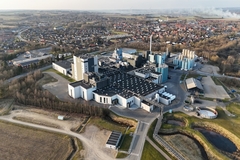
- Industry news
Industry news
- Category news
Category news
- Reports
- Key trends
- Multimedia
Multimedia
- Journal
- Events
- Suppliers
- Home
- Industry news
Industry news
- Category news
Category news
- Reports
- Key trends
- Multimedia
Multimedia
- Events
- Suppliers
Eye in the sky: Agri satellites above Ukraine poised to avert crop disruptions and supply shortages

20 Jan 2023 --- A satellite platform operating in the skies above Ukraine, currently monitoring the country’s crucial crop outputs during wartime, is set to expand. It will offer collected data and analysis to other countries looking for help in rapidly assessing dynamic crop changes, potentially anticipating food chain disruption, shortages and famines.
NASA Harvest and Planet Labs, in partnership with the University of Maryland in the US and the University of Strasbourg in France, have been using satellite imaging to analyze crops from above, tracking their day-to-day changes.
The assessment system, currently monitoring crops in Ukraine, will be made widely available to governments, NGOs and interested parties, aiming to provide data to inform decisions made by key policymakers.

Since the joint platform debuted in 2022, Planet’s fleet of satellites has been “monitoring frontline agricultural activity and the impact of war on crop production” as part of a team dedicated to building crop maps, estimating yield and similar analyses to track rapid crop changes.
 The joint NASA-Planet satellite platform has detected larger-than-expected Ukrainian wheat harvests.Spotlight on Ukraine
The joint NASA-Planet satellite platform has detected larger-than-expected Ukrainian wheat harvests.Spotlight on Ukraine
Josef Wagner, NASA Harvest researcher, tells FoodIngredientsFirst some unexpected observations from the platform above Ukraine.
“Perhaps the most surprising information gleaned from the satellite imagery over Ukraine is that there is more crop production in the Russian-occupied areas than was initially expected,” he notes.
“Ukrainian farmers planted winter crops before the beginning of the war. Eventually, we saw crops being massively shelled then still being harvested a few weeks later, demonstrating the massive resilience capacity of the farmers facing the war. Currently, continuously dropping wheat prices indicate this mitigated impact of the Ukrainian conflict on grain market prices.”
However, the platform spotted expected damages across the frontline.
“Additionally, spring crops were planted in occupied territories, despite the war. However, barren crops were much more frequent along the front line than those in occupied territories.”
“Ukraine mobilized a big team on our side,” notes Wagner.
“We had a team working on in-season crop type mapping, field boundary delineation, planting, and harvesting detection and crop damage detection via artillery crater mapping and counting.”
“Each of us had to improve and develop new methods on the go. Planet provided huge amounts of data in record time, and they still do. We are working on the first insights on winter crop planting 2022 for the 2023 season in Ukraine.”
The main purpose of this platform is to respond to critical information needs, stresses Wagner.
The needs can vary from planting and production analyses in support of local food security and global market stability, as is the case with Ukraine, to drought impacts on agricultural production, currently seen playing out in Somalia.
“Providing data to NASA Harvest was one of our earliest humanitarian response projects we undertook at the outset of the Russo-Ukrainian War,” adds Melissa Rosa, impact programs manager at Planet Labs.
“It’s incredible what they’ve done with that project and we’re excited to see how this grows as more organizations can now benefit from the expanded accessibility.”
 Image Satellite data and subsequent analysis will be made available at a broader level to governments and NGOs. (Image credit: Planet) High resolution
Image Satellite data and subsequent analysis will be made available at a broader level to governments and NGOs. (Image credit: Planet) High resolution
Wagner notes the value of satellite data as a resource.
“While satellite data will not end world hunger, it can provide information that helps in food shortage mitigation planning ahead of a famine,” he explains.
“Satellite data has exceptional benefits, particularly when ground access is limited. We cannot learn everything there is to know strictly from satellite data alone. However, this information can provide key insights to crop production, crop location, cropping practices, changes from one season to the next, extreme weather impacts on agriculture, agricultural productivity in conflict zones, and more.”
Frequent updates add tremendous value to the data provided by the platform.
“The 3-meter resolution commercial data, which Planet provides daily, is particularly critical. This daily revisit is key because it allows us to capture information on almost every field across the globe daily. This is critical as agriculture is dynamic and changes rapidly throughout the growing season,” notes Wagner.
“The daily cadence means we have much higher chances of cloud-free observation, even in cloudy regions. Ultimately, this means that we can achieve close to cloud-free composite images, giving us a clearer picture of agricultural indicators over a shorter period of time.”
The data can illustrate how much of a crop is expected to be produced and harvested, helping to inform trade decisions. It can also provide “early warning” of impending crop shortfalls that can inform anticipatory action and response.
“Crucially, it can highlight key indicators of food security risks, such as drought conditions, potentially providing advanced warnings to mitigate food security disruptions proactively,” continues Wagner.
“These are the applications that satellite data has, but it only works if we are closely connected with decision makers and their information needs,” he points out.
“A key role for satellite data is to help resolve uncertainty around agricultural production of major market players, both exporting and importing countries. Furthermore, as climate extremes continue to increase, we anticipate a stronger need for the ability to monitor agri-food systems in real-time.”
NASA and Planet
NASA Harvest, the US federal space agency’s own Global Food Security and Agriculture Program, has previously worked with Planet, founded in 2010 by three NASA scientists. Planet designs, builds, and operates the largest Earth observation fleet of imaging satellites, capturing over 30 terabytes of data every day.
In related news, Barclays recently released a report examining how the war in Ukraine, coupled with extreme weather events, is threatening global food security. In response to the conflict, the EU and FAO are jointly providing a fund of US$15.5 million to ensure and support Ukrainian food systems impacted by the ongoing war. However, the World Bank has warned that any ‘better-than-projected’ crop successes in Ukraine may be offset by Russian disruptions.
By James Davies
Primary image credit: Xavier Bailleau










